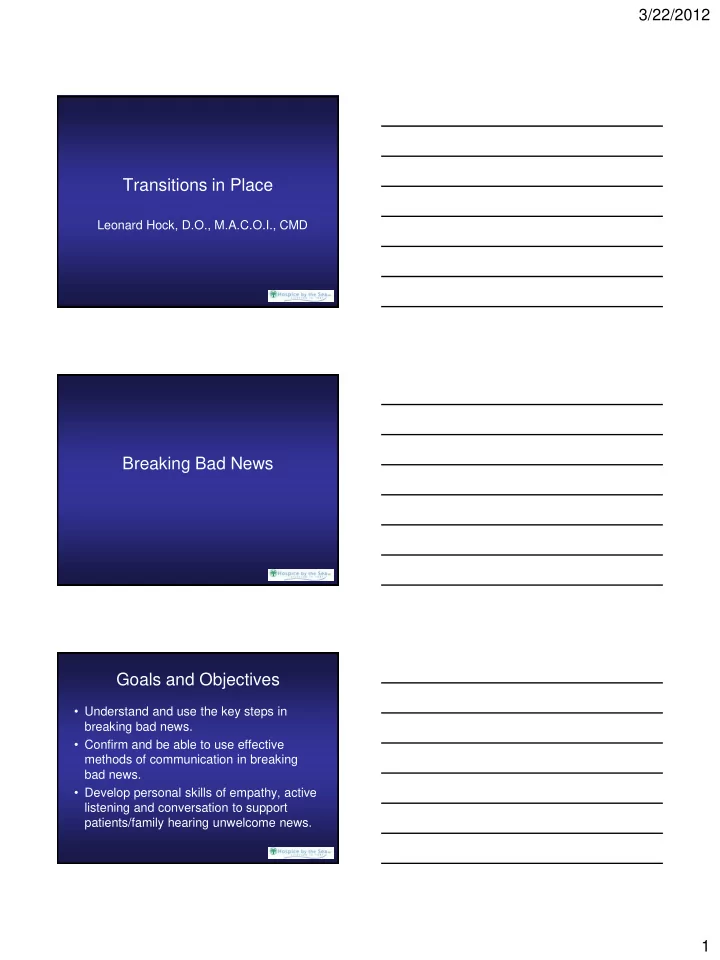

3/22/2012 Transitions in Place Leonard Hock, D.O., M.A.C.O.I., CMD Breaking Bad News Goals and Objectives • Understand and use the key steps in breaking bad news. • Confirm and be able to use effective methods of communication in breaking bad news. • Develop personal skills of empathy, active listening and conversation to support patients/family hearing unwelcome news. 1
3/22/2012 Avoidable Readmissions • 1 in 5 Medicare patients who are discharged from the hospital are readmitted within 30 days. • The annual cost is $17 billon. • Readmission less likely if seen by a doctor within 2 weeks of hospital discharge. • October 2012, hospitals will be penalized and receive lower payments for readmits. Readmission Stats, Living Well, N. Clause Avoidable Readmissions • Until 2015, acute MI, heart failure and pneumonia will be the focused Dx. • The goal is to reduce payments to hospitals by $710 million each year. • Many of these patients live in the long term care continuum. Hospital Response • Cooperate with CMS to reduce readmissions. • More information and education for patient and caregiver at discharge. • More home health referrals. • Hospital based “House call” teams. • Assign Hospitalists to nursing homes. 2
3/22/2012 Hospitalists in Long Term Care • Not relationship formers. • Don’t know our model of care. • No knowledge of F tags or surveys. • Not aware of limitations of interventions. – Labs, IVs, Rx • Share the goal of keeping patient out of hospital. What Can We Do? • Continue to give excellent care • Identify the expected decline in frail elderly • Re set the goals of care based on prognosis • Communicate with family and loved ones • Break the bad news • End of life care, comfort care • Eliminate medical futility Bad News • “There was no response to treatment.” • “The disease has progressed.” • “We’ve done all we can.” • “There is nothing more we can do for you.” • “Any further treatment would be like beating a dead horse.” 3
3/22/2012 Perception of Death and Dying • 80% of Americans believe that death is related to a medical mistake. • Kelly Cranmer quoted in Time magazine. “Death in Asian cultures is expected. Death in European cultures is accepted. Death in the U.S. is optional and in nursing homes it’s against the law.” Life is Good • Widely held and deeply felt desire to live. • Death has become a mystery. • The desire to live, the fear of the unknown and belief that death can be avoided make death unacceptable. Disbelief • “After all, doctor, there are miracles everyday.” • “Are you asking me to give up hope?” • “I only have one Mother and you aren’t going to do anything to save her?” 4
3/22/2012 Reality • Everyone dies (on this earth). • The average life span is about 79 years. • Technology does not equal immortality. • No prescription for pure health and life. • Old age is not a drug deficiency disorder. • Feeding tubes, kidney dialysis and mechanical ventilators are not forever. Death • Sudden death 10% • Predictable death 90% • Who tells the patient/family? • Doctors? • Nurses, Social Workers, Chaplains? • How is the conversation? • Spontaneous, accidental, planned? Things Doctors Like to Do • Like • Don’t Like – Medical Records – Administration – Taking credit for – Meetings positive outcomes – Algorithms of Care – Being off call – Medical Records – Being in charge – Breaking Bad News – Being in charge and – Learning how to Break off call Bad News – Breaking Bad News 5
3/22/2012 Breaking Bad News • Soft or fact based approach? • Euphemisms are not usually helpful. • “Beating around the bush” is awkward. • The news is often emotionally paralyzing. • The Bad News causes instant deafness. • Immediate disbelief and bargaining. “No, it can’t be true. What are the options. We need a second opinion.” Breaking Bad News • Deliberate conversation. • Situational awareness. • Active listening. • Immediate emotional support. • Continued emotional support. • Commitment that the patient will not be abandoned and care will continue. Breaking Bad News • Ownership of information – “What do you know about your condition?” – “How much do you want to know?” • Continuum of care and support – You will continue to be important – You can expect good care • Patient/family in charge of their own life. – “What are your wishes?” 6
3/22/2012 Breaking Bad News • How much do you know about your condition? – Listen • How much do you want to know about your condition? – Be prepared to answer Breaking Bad News • Take the time and make the time for the entire conversation. • Be Empathetic. “You must be worried.” “This must be a difficult time for you.” • Don’t give more information than is requested. • Stay upbeat (for yourself and the patient) Breaking Bad News • This is a sentinel conversation. • It will be remembered by patient and family. • The room, the noise, your facial expression and your words will come up in many conversations. • We have one time to do it right. 7
3/22/2012 The Upside • A good conversation about bad news will support the patient/family. • Confirmation of continued care (palliative) and support is vital. • Letting the patient/family know they are important is powerful and meaningful. Thank you References • Breaking Bad News; Bruce Ambuel, PhD and David Weissman, M.D. AAHPM • Faulkner A. Breaking Bad News a flow diagram. Palliative Medicine 1994:8; 145 • Quill TE, Bad news: Arch Intern Med 1991; 151:463 8
Recommend
More recommend